|
|
|
Published
on 29
Sep 2008
|
All rights reserved.
|
|
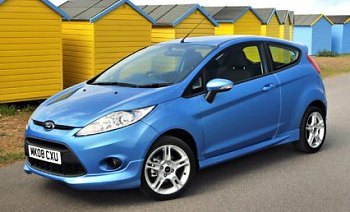
Fiesta
used to be the most important model (together with Focus) to European
Ford. Since its birth in 1976, it has been continuously in production
and some 12 million copies were sold. Now it is becoming even more
important: thanks to Alan Mulally’s cost cutting strategy, global
warming and oil crisis, the European supermini will be available to
North America market for the first time ! This mean it will be Blue
Oval’s first “World Car” since Mondeo Mk1 and Focus Mk1.
Like the last generation, the new Fiesta shares platform with Mazda 2
(Demio). As much as 50 percent components are common to both cars, but
you won’t find any traces of this because it has a totally unique
packaging, chassis tuning and some different engines. Ford’s design
department did a great job to give it a stylish exterior no matter in 3
or 5-door form. It follows Mondeo to employ a large trapezoidal grille,
steeply raked windscreen and rising shoulder line to deliver a sporty
image. The 3-door Zetec-S model with extra skirts and stylish 16-inch
alloy wheels looks especially sporty. Young drivers will love it.
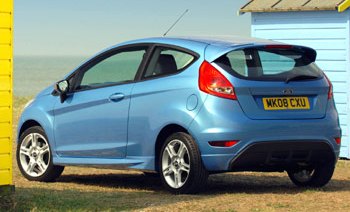
Inside, the cabin tries very hard to be young and different. There is a
center console inspired by the control interface of Nokia mobile
phones. The main console surface, dials, grab handles and the like are
finished in alloy effect plastics. Frankly, they appear to be funky
rather than tasteful. However, the big upper dash surface which fill
your eyes is made of quality soft-touch plastics as you would expect in
a top European supermini. Fit and finish of the cabin also deliver an
air of quality. Noise insulation is first class - no matter wind,
engine or tire noise are very well insulated from the cabin. These
qualities elevate it above its Mazda sibling.
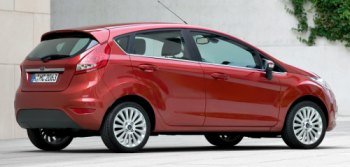
Like any
typical
European Ford products, the front seats here are supportive and
comfortable. The fast windscreen did little to affect front headroom
because the cab is so forward. Tall guys will enjoy the space up front,
especially compare with the rear. Predictable for the class, rear knee
room is tight for 6-footers. Otherwise few people would upgrade to the
larger Focus. The weakest link is not the amount of rear seat space,
but the rather conventional rear seat arrangement. The seatback may
fold forward, but the resultant load area is not flat. Fiesta doesn't
try to be a MAV at all.
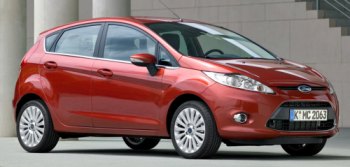
That's not bad, as Fiesta has always been a driver's car instead of a
housewife's car. In this generation, it is benefited from the
lightweight engineering of Mazda 2. Engine by engine, the new Fiesta is
40 kilograms lighter than the old car. That might sound less impressive
than Mazda, which cut 100 kg from its predecessor, but in return you
get a more stylish and higher quality packaging as well as better
refinement from the Ford. The weight reduction does not call for any
expensive aluminum or composites. It trimmed weight component by
component, even up to a screw. Trim weight also helps trimming the
rising material costs, so it is good to both Ford and consumers.
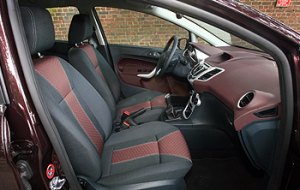
The
Mazda 2
platform
utilizes MacPherson struts suspensions up front and torsion beam at the
rear like most other cars in the class. Ford also follows this format,
although it gets different bushings, springs and dampers to deliver an
even better combination of ride and handling. On the road it feels
agile, responsive and well balanced. Ride is smooth and quiet on
standard car.
Zetec-S with stiffer setup and 10mm lower ride height trades some ride
suppleness for tighter body control. The only let down is the steering,
which follows the trend to switch from hydraulic to electrical
assistance. It is lighter, more rubbery and less communicative than the
old helm, thus ruining the greatest asset of the old Fiesta. That said,
compare with other superminis employing similar steering, its setup is
already one of the best. Overall speaking, the new Fiesta still
delivers the best chassis dynamic of the class.
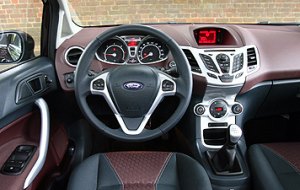
Ford offers 3 petrol engines (60 and 80hp 1.25-liter 16V, 90hp
1.4-liter 16V and 120hp 1.6-liter Ti-VCT 16V) and 2 diesel engines
(68hp 1.4TDCi and 90hp 1.6TDCi) to the new Fiesta. Pick of the range is
the new 1.6 Ti-VCT, which offers twin-variable valve timing. Although
it is not exactly a fireball, it delivers smooth and adequately
flexible power yet returns a remarkable 47.9 mpg fuel consumption. The
1.6TDCi is also a willing and refined performer. Mate to them is an
excellent 5-speed gearbox whose short and slick gearshifts delight keen
drivers.
As seen, the new Ford Fiesta has an all-round package - good handling,
ride, refinement, powertrain, stylish packaging and quality build. It
deserves to win the global challenge.
|
Verdict:      |
| Published
on 20
Mar
2013 |
All rights reserved.
|
|
Fiesta ST
|
|
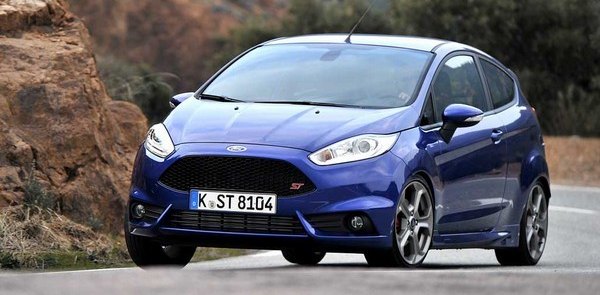
|
Following the introduction
of Renault Clio RS, Citroen DS3 Racing, Mini JCW and Peugeot 208 GTi,
these days 200 horsepower is considered to be a must for a B-segment
hot hatch to challenge for the class leader title. However, does more
equal to better? Not necessarily. More power usually leads to more
weight, and the higher performance it brought needs stiffer suspension
and fatter tires to match. The result is a harsher ride that makes the
car less enjoyable to drive on B-roads, and a handling attitude that is
less keen to steer on throttle. Moreover, the higher costs associated
with enhanced performance will make the small hot hatches out of the
reach of most drivers. This hurt both the manufacturers and motorists.
Ford is wise to keep the Fiesta ST relatively cheap and simple. It is
powered by the familiar 1.6 Ecoboost direct-injected turbocharged
engine which produces 182 hp and 177 lbft of torque (or 214 lbft for a
short period of overboost). It employs a basic 6-speed manual gearbox
instead of the DCT of, say, new Renault Clio RS turbo. As it is not
overly powerful, it saves the need for sophisticated front suspensions
and limited slip differential. A simple brake-actuated torque vectoring
system is considered to be sufficient. These factors enable it to
undercut its Renault and Peugeot rival by 10 percent in price. At this
affordable end of the market, 10 percent makes a big difference to
buyers!
Although it isn't as quick as the aforementioned rivals, the Ecoboost
engine still produces respectable power and good spread of torque. With
minimal turbo lag, it offers excellent flexibility for everyday driving
while fuel economy should be much better than old-school high-revving
motors like that of the old Clio RS. The 137 mph top speed and 0-60 mph
acceleration in 6.6 seconds are more than adequate. The sound produces
by the engine might be a bit uninspiring, but the same can be said to
most modern turbocharged fours elsewhere, and that's the price you paid
for living a greener life. The gearshift isn't as slick as the best
Japanese gearboxes, but it is quick, precise and delightful to use.
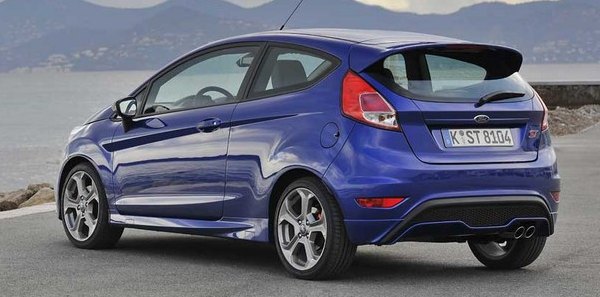
|
Modifications to the chassis are not particularly radical either. The
suspension is lowered by 15 mm and stiffened by about 12 percent. The
front suspension geometry is revised to give a bit more negative
camber. The steering rack ratio is tightened to 2.4 turns lock to lock
(it still goes without variable ratio), while the electrical assistance
is retuned to be heavier. The front brakes are enlarged while the rear
drums are finally replaced with disc brakes. Stylish 17-inch alloy
wheels are shod with relatively narrow Bridgestone Potenza 205/40VR17.
These modifications might be mild, but don't forget that they are based
on the best chassis in the B-segment world, and the tuning skill of
Ford is not to be ignored. On the road, the Fiesta ST is fun to drive.
It feels agile and keen to turn in, as you would expect for the hot
version of Fiesta. The electrical power steering is accurate and
linearly loaded to give a good sense of what the front tires are doing,
even though it is not as feelsome as the best hydraulic racks in the
past. Push it on mountain roads, the stiffer suspension keeps the car
stable and composed without hurting bump absorption on poor surfaces.
It rides with a composure rarely found on high-performance rivals. Roll
resistance is not as tight as some, but the initial roll it displays
contributes to feel and it settles quickly thereafter. Torque steer is
not detectable. Traction is excellent. The torque
vectoring electronics work smoothly behind
the scene so that you are unlikely to be aware of its intervention.
Most remarkable is the inherent balance of the chassis. If you switch
the 3-mode stability control to Off position, the car will dance on
either sides of neutral depending on throttle input. Keep pushing to
the limit and it understeers gently. Lift off mid-corner and it
oversteers a bit. Apply counter steer and you can enjoy an interactive
maneuvering like Mazda MX-5. A hot hatch with wider tires or poorer
balance can never be as playful.
Another remarkable thing about it is the good match between engine and
chassis. The power does not overwhelm the chassis. Neither does the
grip level overwhelms the power. You can push the car right up to the
limit without worrying of overloading either sides. Consequently, it
tempts you to push harder and harder to search for its performance
envelop, which is a rewarding process.
Having said that, the Fiesta ST is not as sharp as the outgoing Clio RS
Cup. Neither can other modern hot hatches, including the new Clio RS
turbo, match the old classic in this respect, blame to the call for
green motoring. As far as the current generation is concerned, the
Fiesta ST is probably the best choice. It might look a bit outdated
outside and inside (despite of nice Recaro seats), but it excels in
what counts to us: driving thrills. And simultaneously it meets the
modern expectation for refinement, fuel economy and practicality. That
makes it a bargain.
|
Verdict:      |
| Published
on 21
Jun
2016 |
All rights reserved.
|
|
Fiesta ST200
|
|
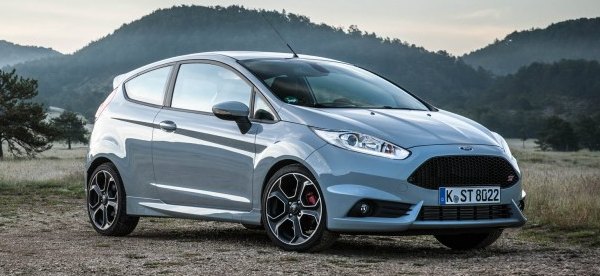
|
Since it went on sale 3
years ago, Ford Fiesta ST has been unbeaten in the B-segment hot hatch
ranking, thanks to its responsive chassis and keen driver interaction.
However, in terms of power and straight line performance it has never
been top notch. Cars like Peugeot 208 GTi, Citroen DS3 Performance,
Renault Clio RS220 and Opel Corsa OPC offer in excess of 200 horsepower
and are quicker to 60 mph by half a second. Ford responded by offering
Mountune tuning kits as deal options, which raises output by 10
percent. Now the kits are adopted in the production car called ST200,
which is also the farewell edition before the next generation Fiesta
enters production next year.
As expected, the changes made to the final edition are hardly radical.
The Mountune engine kits include rewritten ECU and an extra induction
pipe for freer breathing. It raises the engine’s rated output from 182
hp and 177 lbft to 200 hp and 214 lbft, which are actually the same as
what the outgoing engine produced in overboost. There is no need for
any changes in the engine’s internals, cooling or lubrication systems.
On the top of that, it also provides an overboost function for up to 20
seconds, this time producing 215 hp and 236 lbft. Mind you, American
version of the car has this overboost listed as rated output even
though the engine is exactly the same. Thanks to the extra power, the
Fiesta now takes 6.4 seconds to sprint from rest to 60, an improvement
of two-tenths. Its top speed takes a bigger leap from 137 to 143 mph.
While this is still not exactly the fastest in class, it no longer
feels underwhelming. Ford has also shortened the final drive ratio by 6
percent, so the ST200 feels brisker in any gears. The revised induction
also dials up the sound volume a little.
The ST200 also sports improved chassis tuning, although the lesser ST
also gets the same treatment now. Its front anti-roll bar and rear
torsion beam get considerably stiffer, while springs and dampers get
slightly softer. Ride height is dropped by 15 mm. The steering rack
gets quicker ratio, shorter steering arms and revised assistance
mapping. The brakes are enhanced with larger master cylinders and rear
discs. Electronic stability control and torque vectoring software have
also been retuned. These changes are well judged, as the new car rides
better over low-speed bumps yet the responsive turn-in gets even
sharper. Most important, it keeps the playful lift-off oversteering
intact,
so that while it is not the fastest car in the class it is still the
most entertaining. The only area it can be improved is the lack of LSD,
which is evident when pushing the car in tight corners. Considering
Peugeot 208 GTi bPS has Torsen LSD fitted as standard yet costing less
to buy, the ST200 seems overpriced. You pay premium for its fame.
|
Verdict:      |
|
|
|
|
|
|
|
|
|
Fiesta
1.6TDCi
|
2008
|
Front-engined,
FWD
|
| Steel monocoque |
| Mainly steel |
| 3950 / 1722 / 1481 |
| 2489 mm |
Inline-4, diesel
|
| 1560 cc |
DOHC 16 valves
|
| Turbo |
| CDI |
| 90 hp |
150 lbft
|
5-speed manual
|
F: strut
R: torsion-beam
|
| - |
195/50R15
|
1119 kg
|
109 mph (c)
|
11.0 (est)
|
-
|
|
Fiesta
1.6 Zetec-S
|
2008
|
Front-engined,
FWD
|
| Steel monocoque |
| Mainly steel |
| 3950 / 1722 / 1481 |
| 2489 mm |
Inline-4
|
| 1596 cc |
DOHC 16 valves, VVT
|
| - |
| - |
| 120 hp |
112 lbft
|
5-speed manual
|
F: strut
R: torsion-beam
|
| - |
195/45VR16
|
1045 kg
|
120 mph (c)
|
9.3 (c) / 8.7*
|
27.3*
|
|
Fiesta
1.0 Ecoboost
|
2013
|
Front-engined,
FWD
|
| Steel monocoque |
| Mainly steel |
| 3969 / 1722 / 1495 |
| 2489 mm |
Inline-3
|
| 999 cc |
DOHC 12 valves, DVVT
|
| Turbo |
| DI |
| 125 hp |
125 lbft (overboost 147 lbft)
|
5-speed manual
|
F: strut
R: torsion-beam
|
| - |
195/45VR16
|
1101 kg
|
122 mph (c)
|
8.8 (c) / 8.3*
|
-
|
|
|
|
|
|
Performance
tested by: *C&D
|
|
|
|
|
|
|
Fiesta
ST
|
2013
|
Front-engined,
FWD
|
| Steel monocoque |
| Mainly steel |
| 3969 / 1764 / 1468 |
| 2489 mm |
Inline-4
|
| 1596 cc |
DOHC 16 valves, DVVT
|
| Turbo |
| DI |
182 hp (overboost 200 hp)
|
177 lbft (overboost 214 lbft)
|
6-speed manual
|
F: strut
R: torsion-beam
|
| - |
205/40VR17
|
1163 kg
|
137 mph (c)
|
6.6 (c) / 7.0* / 6.7**
|
17.0* / 17.0**
|
|
Fiesta
ST200
|
2016
|
Front-engined,
FWD
|
| Steel monocoque |
| Mainly steel |
| 3975 / 1709 / 1456 |
| 2489 mm |
Inline-4
|
| 1596 cc |
DOHC 16 valves, DVVT
|
| Turbo |
| DI |
200 hp (overboost 215 hp)
|
214 lbft (overboost 236 lbft)
|
6-speed manual
|
F: strut
R: torsion-beam
|
| - |
205/40VR17
|
1163 kg
|
143 mph (c)
|
6.4 (c)
|
-
|
|
|
|
|
|
|
Performance
tested by: *Autocar, **C&D
|
|
|
|
|
|
|
|
Copyright©
1997-2016
by Mark Wan @ AutoZine
|
|